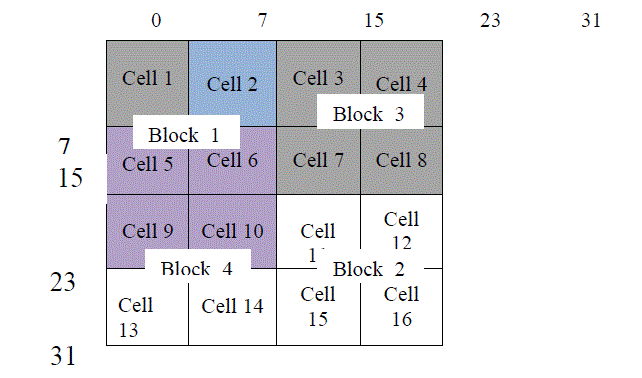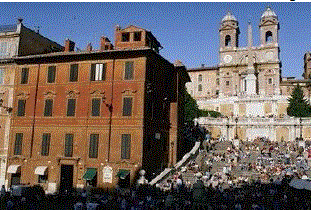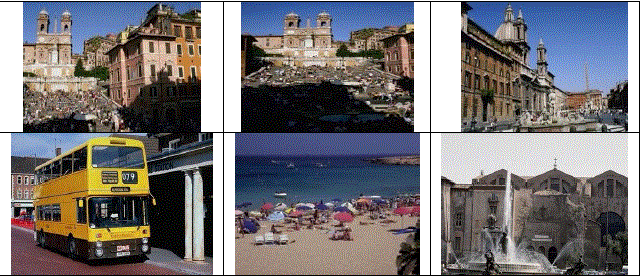Data mining software analyzes relationships and patterns in stored transaction data based on open-ended user queries. Content-Based Image Retrieval (CBIR) is the application of computer vision techniques and it gives solution to the image retrieval problem such as searching digital images in large databases. Retrieving most relevant images from a bulk database is difficult. Images can be retrieved using both color and texture based on relevance feedback technique. Image is first subjected to separation of RGB components and then the features are extracted for all the three components. Discrete Wavelet Transform (DWT) is used for analysis of textures recorded with different resolution. Histogram of Oriented Gradient (HOG) is used for extracting features for the images. CORAL image Database is used to find the relevant images using MATLAB Software. Feedback from the user helps to identify the images accurately even if the color and texture property method fails to attain the accuracy. Similarity comparison technique is used for good performance of the CBIR system. The proposed system is operated on a JPEG image database containing 1000 general-use color images. Helps to improve the accuracy and reduces time consumption in filtering same images.
Keywords |
| Discrete Wavelet Transform, Histogram of Oriented Gradient, Content-Based Image Retrieval. |
INTRODUCTION |
| Content-Based Image Retrieval (CBIR) systems were introduced to address the problems associated with text-based image
retrieval. CBIR is a set of techniques for retrieving semantically-relevant images from an image database based on
automatically-derived image features [1]. The main goal of CBIR is efficiency during image indexing and retrieval, thereby
reducing the need for human intervention in the indexing process. CBIR systems mainly involve research on databases and
image processing handling problems which varies from storage issues to user friendly interfaces [2]. CBIR systems are
mostly developed in Database Management Systems (DBMS). |
| One of the most important features visually recognized by humans in images is color. Humans tend to distinguish images
based mostly on color features. Because of this, color features are the most widely used in CBIR systems and the most
studied in literature. Color is a powerful descriptor that simplifies object identification, and is one of the most frequently
used visual features for content-based image retrieval. To extract the color Efficient Content Based Image Retrieval features
from the content of an image, a proper color space and an effective color descriptor have to be determined. The most
commonly used method to represent color feature of an image is the color histogram. A color histogram is a type of bar
graph, where the height of each bar represents an amount of particular color of the color space being used in the image [3].
The color histogram can not only easily characterize the global and regional distribution of colors in an image, but also be
invariant to rotation about the view axis. Generally, different objects of the same color are expected to have different
texture patterns. Therefore, color feature alone is not enough to differentiate images. Color feature in combination with
other features such as texture and shape provides more accurate CBIR performance. |
| Texture is an important and prominent visual property of an image. Low-level texture features play a vital role in CBIR
and texture classification. Defining texture is difficult. Almost all the natural and real world images are composed of
different kinds of objects. In a simpler way, it can be said that the surface pattern of an object in the image or of the whole
image is known as the texture. Similar images are expected to have similar texture patterns, so texture features are important for content based image retrieval. However, texture can be thought of as repeated patterns of pixels over a spatial
domain, of which the addition of noise to the patterns and their repetition frequencies results in textures that can appear to
be random and unstructured. Texture properties are the visual patterns in an image that have properties of homogeneity that
do not result from the presence of only a single color or intensity. The different texture properties as perceived by the
human eye are regularity, directionality, smoothness, and coarseness. |
| Query by Example (QBE) is generally accepted paradigm in the CBIR field in which user can use an example to query
the CBIR system and expect to obtain similar images to the query image. CBIR system would extract visual features from
the query image and measure the similarities of the image in an image database. QBE is the most representative way due to
ease of similarity measure. |
| Relevance Feedback (RF) is introduced into CBIR systems inorder to better capture the user’s required information
through iterative feedback and query refinement. Relevance Feedback is the process of automatically adjusting an existing
query using the information feedback by the user about the relevance of previously retrieved objects such that the adjusted
query. The key issue in relevance feedback is how to effectively utilize the feedback information to improve the retrieval
performance [4]. |
| The paper can be organized as follows: Paper can be organized as follows: Section II describes about related works.
Section III describes about the algorithms used in the proposed methodology. Section IV deals with the results obtained
during experiment. The concluding work is presented in section IV. |
II. RELATED WORKS |
| A content-based image retrieval method which combines color and texture features is adopted inorder to improve the
discriminating power of color indexing techniques and also a minimal amount of spatial information is encoded in the color
index. As its color features, an image is divided horizontally into three equal non-overlapping regions. From each region in
the image, the first three moments of the color distribution is extracted from each color channel and store them in the index
i.e., for a HSV color space, 27 floating point numbers per image is stored. As its texture feature, Gabor texture descriptors
are adopted. Weights are assigned to each feature respectively and the similarity is calculated with combined features of
color and texture using Canberra distance as similarity measure [5]. |
| An approach is proposed to minimize the size of feature vector to reduce the system complexity and to obtain faster
retrieval. Feature vector is extracted using frequency domain analysis of them image. Transform coefficients of applied
transform is obtained and use them as image feature. Frequency domain calculations were made using DCT [6]. The
method of image search and retrieval proposed here mainly focuses on the generation of the feature vector of search based
on the image transform generated by the Discrete Cosine Transform (DCT). DCT of each R, G and B component of images
is used separately to generate feature vectors of dimension (1×3) which is very small in size as compared to using full
transform as a feature vector. For all images 3 components i.e. 1 component of R, G and B are considered for feature vector
generation. Thus the algorithm is very fast as compared to the algorithms using full transforms. |
| A novel framework for combining the entire three image features i.e. color, texture and shape information is presented.
The image and its complement are partitioned into non-overlapping tiles of equal size. The features drawn from conditional
co-occurrence histograms between the image tiles and corresponding complement tiles, in RGB color space, serve as local
descriptors of color and texture. This local information is captured for two resolutions and two grid layouts which provides
different details of the same image. An integrated matching scheme, based on most similar highest priority (MSHP)
principle and the adjacency matrix of a bipartite graph formed using the tiles of query and target image, is provided for
matching the images. Shape information is captured in terms of edge images computed using Gradient Vector Flow fields
[7]. Invariant moments are then used to record the shape features. |
| A fast and robust color indexing techniques, namely auto color correlation (ACC) based on a color correlogram (CC), is
presented for extracting and indexing low-level features of images. This technique reduces the computational time of color
correlogram technique from O(m2d) to O(md) [8]. Additionally, an extended technique of ACC based on the auto
correlogram, namely Auto Color Correlogram and Correlation (ACCC) is also proposed by them. It is the integration of
Auto correlogram and Auto Color Correlation techniques that the computational time of ACCC is still O (md). |
| Images can be retrieved using color-based, texture-based and color and texture-based in this method. Auto color
correlogram is an extension of the correlogram technique for color indexing. The proposed method uses auto color
correlogram for color based image retrieval. A gaussian mixture model is one of the density models which include a
number of component Gaussian functions. These functions are combined with different weights to form a multi-modal
density. Gaussian mixture models are a semi-parametric which can be used instead of non-parametric histograms (which
can also be used to approximate densities). It has high flexibility and precision in modeling the underlying distribution of
sub-band coefficients. In this study, Query point movement is used as a relevance feedback technique for Content Based
Image Retrieval systems. Thus the proposed method achieves better performance and accuracy in retrieving images [9]. |
METHODOLOGY |
| CBIR uses the contents of images to represent and access the images. A typical CBIR system is divided into off-line
feature extraction and online image retrieval. A conceptual framework for CBIR is illustrated in Figure 1. |
| 1. Separating RGB coordinates of an image into HSV |
| The RGB image based features has some drawbacks in extracting the features. Hence each query image is separated into
its three components Red, Green and Blue (RGB) color space and from that features are extracted. Extracted features of
RGB coordinates are converted in HSV color space to process images exactly based on intensity. |
| The HSV values of a pixel can be transformed from its RGB representation according to the following formulas: |
 |
 |
 |
| HSV is invariant to the illumination and camera direction, and thus suitable for object recognition. |
| 2. DWT based Feature Extraction
DWT is applied after color space conversion. DWT is efficient in extracting sub bands of images and it also extracts
information from the images at different scales. |
| In discrete wavelet transform, the original image is high-pass filtered yielding three detail images, describing the local
changes in horizontal, vertical and diagonal direction of the original image. The image is then lowpass filtered yielding an
approximation image which is again filtered in the same manner to generate high and low frequency subbands at the next
lower resolution level. This process is continued until the whole image is processed or a level is determined as the lowest to
stop decomposition. |
| 3. HOG based Feature Database |
| Transformed subbands are given to Histogram of Oriented Gradient for extracting its feature vectors. This HOG
descriptor is used to extract the features around the interest points. |
| Inorder to divide the image sub region into cells and blocks to facilitate the HOG feature extraction, the following steps
should be followed: |
| 1. The image is scaled to 32x32 pixels and it is smoothen using a Gaussian filter. |
| 2. Resulting image should be divided into 16 cells such that each cell having 8x8 pixels. |
| 3. A block is formed in each group of 2x2 neighboring cells. Hence the total of 9 overlapping blocks is generated. |
| 4. Compute the horizontal gradients and vertical gradients ( ) for each pixel using I(x, y) in the block as
follows: |
 |
 |
| 5. Then the gradient orientation θ for each pixel is calculated using following equation: |
 |
| 6. Gather the orientations into 8 histogram bins as shown in the figure 1. |
| The eight histogram values from each block are joined together to produce a 72-dimension HOG feature vector. This
feature vector is used for the classifier training. |
| 4. Similarity Measure and Relevance Feedback |
| Similarity comparison technique is used for evaluating distance between two images. System learns feedback provided
by the user through relevance feedback. Therefore, Euclidean distance has been taken as a standard to similarity
measurement in CBIR process. |
Euclidean Distance (q, p) =  |
Where,  respectively. By this process feature vectors are extracted for the
images then they are given to HOG based feature extraction. respectively. By this process feature vectors are extracted for the
images then they are given to HOG based feature extraction. |
| Relevance feedback on the image retrieved in response to the initial query. This feedback is used subsequently in
improving the retrieval effectiveness. A relevance feedback approach allows a user to interact with the retrieval algorithm
by providing the information of which images user thinks are relevant to the query .Keyword based image retrieval is
performed by matching keyword according to user input and the images in the database. Some images may not have
appropriate keywords to describe them and therefore the image search will become complex. One of the solutions in order
to overcome this problem is “relevance feedback” technique that utilizes user feedback and hence reduces possible errors
and redundancy. |
IV. EXPERIMENTAL RESULTS |
| The Evaluation is performed to find the relevant images for the given input query with reduced number of iterations. The
experiment is done by using CORAL image Database with the software MATLAB. |
| The accuracy of the image can be calculated by the following formula which is expressed in %: |
 |
| where N is number of relevant images in the database which are known to the user and X is the number of irrelevant
images in the database which are known to the user. |
| The Corel image dataset consists of mainly six different images. The corresponding accuracy of the query images to
display these images before and after relevance feedback has been observed for combined DWT and HOG image retrieval. |
| 1. DWT Based Image Retrieval: |
| The query input image is given by the user. Based on the query image the DWT based retrieval system extracts the
images. The input query is shown in the figure 2. Here in this bus is taken as query image. |
| The figure 3 shows the result based on DWT transform. In this figure two images are not extracted correctly for the
query image building. The accuracy of the output images is 80%. |
| 2. HOG by DWT Subbands based Image Retrieval: |
| Here the image searches from the database based on the combined algorithm of DWT and HOG based feature extraction.
The same query image of fig 2 building is given also for this process. |
| Result of DWT with HOG: |
| Iteration 1 (Before Relevance Feedback): |
| Figure 4 illustrates the output images based on DWT with HOG features for the user’s input query. The output figure
shows that for building query image one image of people is extracted by it. This became error image. This image has to be
replaced. This can be done by using relevance feedback process.The accuracy of the output images obtained in the first
iteration is 88%. |
| Iteration 2 (After Relevance Feedback): |
| Then Figure 5 shows the output images based on combined DWT and HOG after relevance feedback. The accuracy of
images obtained in the second iteration is 98%. In this iteration itself the maximum output is produced, if maximum
accuracy is not produced means next iteration can be done. This process can be carried till maximum accuracy is obtained. |
3. Performance Evaluation |
| The Corel image dataset consists of mainly six different images. The corresponding accuracy of the query images to
display these images before and after relevance feedback has been observed for combined DWT and HOG image retrieval.
The accuracy before and after relevance feedback for this image retrieval is shown in the table 1. |
| Table 1 illustrates that the average number of iteration for the six datasets is 2 and the maximum accuracy after relevance
feedback is 86%. |
| The experimental result proved that the proposed method produces the nearly maximum accuracy for image retrieval. |
V. CONCLUSION |
| The study of CBIR along with various feature extraction algorithms is performed. Numerous methods are available for
CBIR. They are identified and studied to understand the image retrieval process in the CBIR systems. A method based on
HOG by DWT subbands is proposed to extract the features of the Image. The RGB image based features has some
drawbacks in extracting the features. So they are separated into its components and from that features are extracted. HOG
descriptor is used to extract the features around the interest points. And though DWT is efficient in extracting sub bands of
images this extracts information from the images at different scales. Then extracted features of the database is compared
with the query image and based on that image is retrieved. The Evaluation is performed to find the relevant images with
reduced number of iterations. The experiment is done by using CORAL image Database with the software MATLAB. The
performance is evaluated using accuracy calculation. By the obtained result, this method can be concluded as a proficient
method. For future research direction in RF can be applied to more kinds of applications on multimedia retrieval or
multimedia recommendation. It can be implemented in other image features with efficient methods to obtain better
performance of the image. |
Tables at a glance |
 |
| Table 1 |
|
| |
Figures at a glance |
 |
 |
 |
| Figure 1 |
Figure 2 |
Figure 3 |
|
 |
 |
 |
| Figure 4 |
Figure 5 |
Figure 6 |
|
| |
|
|





